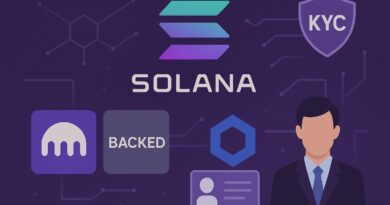U.S. Department of Labor Lifts Crypto Restrictions in Retirement Plans
U.S. Department of Labor Rescinds Crypto Restrictions on 401(k) Plans: A New Era for Retirement Investment
Estimated reading time: 6 minutes
- Regulatory Shift: The U.S. Department of Labor has rescinded its 2022 guidance on cryptocurrencies in 401(k) plans.
- Fiduciary Empowerment: Fiduciaries can now incorporate cryptocurrencies without fear of liability.
- Employee Education: HR must prioritize educating employees on cryptocurrency investment risks and benefits.
- AI Integration: Leveraging AI can streamline investment analysis and compliance tasks.
- Future Opportunities: This change presents a significant opportunity for innovative investment strategies.
Table of Contents
- The Shift in Regulatory Landscape
- Empowering Fiduciaries and Investment Strategies
- Challenges and Considerations for HR Professionals
- Highlighting AI’s Role in Navigating the Changes
- Practical Takeaways for Recruiters & HR Professionals
- Conclusion: A Bright Future for Crypto in Retirement Plans
- FAQ
The Shift in Regulatory Landscape
On May 28, 2025, the U.S. Department of Labor (DOL) officially rescinded prior guidance that instructed fiduciaries to exercise “extreme care” before including cryptocurrency options in 401(k) investment menus. This policy change indicates a significant shift from a previously cautious stance by the Biden administration towards a more neutral approach, allowing retirement fiduciaries to consider digital assets without the burden of heightened scrutiny (source). According to Labor Secretary Lori Chavez-DeRemer, the previous guidance was seen as an attempt to “put their thumb on the scale” against cryptocurrency investments, emphasizing the need for fiduciaries to make decisions based on sound investment principles rather than regulatory pressures (source).
This pivotal decision is about more than just cryptocurrencies; it resonates throughout the financial services industry and impacts many companies, including those involved in AI consulting and workflow automation. This shift allows for a more inclusive investment strategy, potentially increasing the demand and price support for major cryptocurrencies by legitimateizing them as part of the $7 trillion U.S. retirement market.
Empowering Fiduciaries and Investment Strategies
The rescission of the 2022 guidance means that fiduciaries can now freely consider cryptocurrencies as a viable option for retirement plans. This policy change comes at a time when the popularity and acceptance of digital assets are on the rise. As the Department of Labor no longer imposes a cautious or biased lens on these investments, financial professionals can incorporate innovative investment strategies into their financial offerings. The DOL’s new neutral stance allows industry leaders to explore cryptocurrencies without fear of reprisal or potential liability for fiduciary breaches (source).
In practical terms, this means that retirement plan administrators now have the green light to educate and onboard employees about cryptocurrency investments within their portfolios. The ability to include cryptocurrencies could appeal to a more tech-savvy workforce and the next generation of investors who view digital assets as essential components of their financial future.
Challenges and Considerations for HR Professionals
While this progress is notable, HR professionals and recruiters must also consider the potential challenges that come alongside this opportunity. No investment comes without risks, and cryptocurrencies are notoriously volatile. As fiduciaries, it will be essential for HR teams to ensure that they mitigate risks while educating employees about the potential benefits and dangers of including cryptocurrencies in their retirement plans.
- Educating Employees: HR departments should prioritize employee education regarding cryptocurrency investments. Workshops, seminars, and informational resources can demystify the concept of cryptocurrencies and assist employees in making informed decisions about their retirement savings.
- Balancing Risk and Reward: With the potential for significant returns comes the risk of loss. Organizations must strive to find a balanced approach to investment strategies, crafting a portfolio that includes cryptocurrencies alongside more traditional investment options.
- Compliance and Legal Considerations: As the regulatory environment for cryptocurrencies evolves, it will be critical for organizations to stay updated on compliance requirements and adjust their strategies accordingly.
Highlighting AI’s Role in Navigating the Changes
As a consulting firm specializing in AI and workflow automation, we understand the importance of leveraging technology to streamline decision-making processes. By integrating AI-driven tools into investment management systems, organizations can enhance their capabilities when evaluating the inclusion of cryptocurrencies. Automation can help reduce administrative burdens by optimizing data analysis, automating compliance checks, and providing real-time market insights.
AI-powered analytics can facilitate sophisticated risk assessments, allowing fiduciaries to analyze historical cryptocurrency performance alongside traditional securities seamlessly. Moreover, companies can use AI chatbots to enhance employee engagement by providing immediate answers to questions related to retirement options involving digital assets. This allows HR departments to reallocate time to focus on strategic initiatives rather than repetitive inquiries.
Practical Takeaways for Recruiters & HR Professionals
Given the evolving landscape of retirement investment through cryptocurrencies, here are several actionable steps for HR professionals and recruiters:
- Update Employee Benefit Packages: Revise your company’s retirement benefits to explore the addition of cryptocurrencies. Partner with financial advisors to understand how to structure these offerings responsibly.
- Legal Consultation: Collaborate with legal professionals to address compliance issues and ensure adherence to all regulatory requirements.
- Implement AI Solutions: Consider investing in AI-driven consulting and workflow automation services to streamline processes, such as performance analysis and regulatory compliance.
- Create Educational Content: Develop webinars, FAQs, and informative articles to help employees navigate the new investment options and understand cryptocurrencies.
- Feedback Mechanism: Establish channels through which employees can voice their opinions and concerns regarding potential investment options, fostering an open dialogue that enhances trust and engagement.
Conclusion: A Bright Future for Crypto in Retirement Plans
The U.S. Department of Labor’s recent decision to allow cryptocurrencies in 401(k) plans ushers in a transformative period for retirement investment strategies. As this new era unfolds, HR professionals have the unique opportunity to lead by informing and empowering employees in navigating this change intelligently.
At our company, we strive to leverage our expertise in AI consulting and workflow automation to empower organizations in adapting to the evolving regulatory landscape and integrated investment strategies. As more individuals approach retirement with diverse portfolios, staying informed about digital assets and ensuring seamless integration into workplace benefits becomes paramount.
We invite you to explore our services to discover how we can assist your organization in making informed decisions, optimizing workflow processes, and effectively engaging employees about investment opportunities. Contact us today to learn more about how we can support your organization’s goals and help you navigate the exciting developments in the world of crypto-related investment options!
FAQ
What regulatory changes have occurred regarding crypto in 401(k) plans?
On May 28, 2025, the U.S. Department of Labor rescinded prior guidance that discouraged cryptocurrency investments in 401(k) plans.
How should HR professionals respond to these changes?
HR professionals should prioritize employee education and consider integrating cryptocurrencies into retirement plan offerings while balancing potential risks.
What role does AI play in managing these changes?
AI can streamline investment analysis and compliance processes, enabling HR and financial teams to make more informed decisions.



Pingback: generique kamagra en paris
Pingback: cheap enclomiphene cost on prescription
Pingback: ordering androxal cost new zealand
Pingback: cheap flexeril cyclobenzaprine price on prescription
Pingback: buy cheap dutasteride canadian discount pharmacy
Pingback: can you buy gabapentin in mexico
Pingback: online order fildena singapore where to buy
Pingback: buy cheap itraconazole american express
Pingback: order avodart without a script
Pingback: buy cheap staxyn cheap where
Pingback: discount xifaxan generic pharmacy usa
Pingback: how to order rifaximin usa where to buy
Pingback: kamagra online ceny